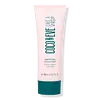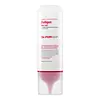What's inside
What's inside
 Key Ingredients
Key Ingredients

 Benefits
Benefits

 Concerns
Concerns

 Ingredients Side-by-side
Ingredients Side-by-side

Water
Skin ConditioningAlcohol Denat.
AntimicrobialCocos Nucifera Oil
MaskingStearyl Alcohol
EmollientPolyquaternium-37
Mentha Piperita Oil
MaskingMenthyl Ethylamido Oxalate
Skin ConditioningDistearoylethyl Hydroxyethylmonium Methosulfate
Pumice
AbrasiveBambusa Arundinacea Stem Powder
AbrasiveMelaleuca Alternifolia Leaf Oil
AntioxidantPiroctone Olamine
PreservativePolyquaternium-11
Pentylene Glycol
Skin ConditioningGlycerin
HumectantCeteareth-20
CleansingCetearyl Alcohol
EmollientChlorphenesin
AntimicrobialCitrus Limon Fruit Extract
MaskingCocos Nucifera Shell Powder
AbrasiveMicrocrystalline Cellulose
AbsorbentMannitol
HumectantAnanas Sativus Fruit Extract
Skin ConditioningPassiflora Edulis Fruit Extract
Skin ConditioningVitis Vinifera Fruit Extract
Skin ConditioningSalicylic Acid
MaskingCI 77266
Cosmetic ColorantLactose
HumectantCoffea Arabica Seed Extract
MaskingCoffea Robusta Seed Extract
Skin ConditioningTriticum Vulgare Bran Extract
Skin ConditioningPhenoxyethanol
Preservative1,2-Hexanediol
Skin ConditioningCaprylyl Glycol
EmollientCharcoal Powder
AbrasiveSorbic Acid
PreservativeSodium Benzoate
MaskingPotassium Sorbate
PreservativeAlgin
MaskingEthylhexylglycerin
Skin ConditioningSodium Hydroxide
BufferingSodium Bisulfite
AntioxidantBenzyl Alcohol
PerfumingLimonene
PerfumingCI 19140
Cosmetic ColorantCI 42090
Cosmetic ColorantWater, Alcohol Denat., Cocos Nucifera Oil, Stearyl Alcohol, Polyquaternium-37, Mentha Piperita Oil, Menthyl Ethylamido Oxalate, Distearoylethyl Hydroxyethylmonium Methosulfate, Pumice, Bambusa Arundinacea Stem Powder, Melaleuca Alternifolia Leaf Oil, Piroctone Olamine, Polyquaternium-11, Pentylene Glycol, Glycerin, Ceteareth-20, Cetearyl Alcohol, Chlorphenesin, Citrus Limon Fruit Extract, Cocos Nucifera Shell Powder, Microcrystalline Cellulose, Mannitol, Ananas Sativus Fruit Extract, Passiflora Edulis Fruit Extract, Vitis Vinifera Fruit Extract, Salicylic Acid, CI 77266, Lactose, Coffea Arabica Seed Extract, Coffea Robusta Seed Extract, Triticum Vulgare Bran Extract, Phenoxyethanol, 1,2-Hexanediol, Caprylyl Glycol, Charcoal Powder, Sorbic Acid, Sodium Benzoate, Potassium Sorbate, Algin, Ethylhexylglycerin, Sodium Hydroxide, Sodium Bisulfite, Benzyl Alcohol, Limonene, CI 19140, CI 42090
Sodium Chloride
MaskingWater
Skin ConditioningCoco-Betaine
CleansingGlycerin
HumectantSea Salt
AbrasiveSodium Cocoyl Alaninate
Lauryl Betaine
CleansingCocamide Mea
EmulsifyingSodium Lauroyl Glutamate
Alcohol Denat.
AntimicrobialPotassium Cocoate
EmulsifyingPPG-3 Caprylyl Ether
SolventTrehalose
HumectantCaprylyl Glycol
EmollientIsopropyl Myristate
EmollientMenthol
MaskingTrihydroxystearin
Skin ConditioningPolyquaternium-10
Panthenol
Skin ConditioningSalicylic Acid
MaskingSucrose Stearate
EmollientTromethamine
BufferingNiacinamide
SmoothingMenthyl Lactate
MaskingMentha Piperita Oil
MaskingZea Mays Oil
EmulsifyingSodium Benzoate
MaskingCaprylic/Capric Triglyceride
MaskingMelaleuca Alternifolia Leaf Oil
AntioxidantArgania Spinosa Kernel Oil
EmollientCamellia Seed Oil
Carum Carvi Seed Oil
MaskingCarica Papaya Fruit Extract
Skin ConditioningPinus Pinaster Leaf Extract
Skin ConditioningButylene Glycol
Humectant1,2-Hexanediol
Skin ConditioningPolysorbate 80
EmulsifyingLecithin
EmollientCeramide NP
Skin ConditioningMentha Piperita Leaf Extract
Skin ConditioningFreesia Refracta Extract
Skin ConditioningMentha Citrata Leaf Extract
AstringentChamomilla Recutita Extract
Skin ConditioningRosmarinus Officinalis Leaf Extract
AntimicrobialLavandula Angustifolia Extract
Skin ConditioningCaffeine
Skin ConditioningAdenosine
Skin ConditioningBiotin
AntiseborrhoeicPearl Extract
AntioxidantVinca Minor Leaf Extract
Skin ConditioningCentella Asiatica Extract
CleansingEthylhexylglycerin
Skin ConditioningZinc Pyrithione
AntiseborrhoeicZingiber Officinale Root Extract
MaskingSodium Chloride, Water, Coco-Betaine, Glycerin, Sea Salt, Sodium Cocoyl Alaninate, Lauryl Betaine, Cocamide Mea, Sodium Lauroyl Glutamate, Alcohol Denat., Potassium Cocoate, PPG-3 Caprylyl Ether, Trehalose, Caprylyl Glycol, Isopropyl Myristate, Menthol, Trihydroxystearin, Polyquaternium-10, Panthenol, Salicylic Acid, Sucrose Stearate, Tromethamine, Niacinamide, Menthyl Lactate, Mentha Piperita Oil, Zea Mays Oil, Sodium Benzoate, Caprylic/Capric Triglyceride, Melaleuca Alternifolia Leaf Oil, Argania Spinosa Kernel Oil, Camellia Seed Oil, Carum Carvi Seed Oil, Carica Papaya Fruit Extract, Pinus Pinaster Leaf Extract, Butylene Glycol, 1,2-Hexanediol, Polysorbate 80, Lecithin, Ceramide NP, Mentha Piperita Leaf Extract, Freesia Refracta Extract, Mentha Citrata Leaf Extract, Chamomilla Recutita Extract, Rosmarinus Officinalis Leaf Extract, Lavandula Angustifolia Extract, Caffeine, Adenosine, Biotin, Pearl Extract, Vinca Minor Leaf Extract, Centella Asiatica Extract, Ethylhexylglycerin, Zinc Pyrithione, Zingiber Officinale Root Extract
 Reviews
Reviews

Ingredients Explained
These ingredients are found in both products.
Ingredients higher up in an ingredient list are typically present in a larger amount.
1,2-Hexanediol is a synthetic liquid and another multi-functional powerhouse.
It is a:
- Humectant, drawing moisture into the skin
- Emollient, helping to soften skin
- Solvent, dispersing and stabilizing formulas
- Preservative booster, enhancing the antimicrobial activity of other preservatives
Alcohol Denat. is an alcohol with a denaturant property. It is created by mixing ethanol with other additives.
This ingredient gets a bad rep because it is irritating and drying - mostly due to its astringent property. Astringents draw out natural oils in tissue, constricting pores and leaving your skin dried out.
However, alcohol denat. is not all that bad.
Due to its low molecular weight, alcohol denat. tends to evaporate quickly. One study on pig skin found half of applied alcohol evaporated in 10 seconds and less than 3% stayed on skin.
This also helps other ingredients become better absorbed upon application.
Studies are conflicted about whether this ingredient causes skin dehydration. One study from 2005 found adding emollients to propanol-based sanitizer decreased skin dryness and irritation. Another study found irritation only occurs if your skin is already damaged.
Small amounts of alcohol are generally tolerated by oily skin or people who live in humid environments.
The rule of thumb is if this alcohol is near the end of an ingredients list, it will probably not affect your skin much.
Also...
This ingredient has antimicrobial and solvent properties.
The antimicrobial property helps preserve products and increase their shelf life. As a solvent, it helps dissolve other ingredients.
Other types of astringent alcohols include:
Learn more about Alcohol Denat.Caprylyl Glycol is a humectant and emollient, meaning it attracts and preserves moisture.
It is a common ingredient in many products, especially those designed to hydrate skin. The primary benefits are retaining moisture, skin softening, and promoting a healthy skin barrier.
Though Caprylyl Glycol is an alcohol derived from fatty acids, it is not the kind that can dry out skin.
This ingredient is also used as a preservative to extend the life of products. It has slight antimicrobial properties.
Learn more about Caprylyl GlycolEthylhexylglycerin (we can't pronounce this either) is commonly used as a preservative and skin softener. It is derived from glyceryl.
You might see Ethylhexylglycerin often paired with other preservatives such as phenoxyethanol. Ethylhexylglycerin has been found to increase the effectiveness of these other preservatives.
Glycerin is already naturally found in your skin. It helps moisturize and protect your skin.
A study from 2016 found glycerin to be more effective as a humectant than AHAs and hyaluronic acid.
As a humectant, it helps the skin stay hydrated by pulling moisture to your skin. The low molecular weight of glycerin allows it to pull moisture into the deeper layers of your skin.
Hydrated skin improves your skin barrier; Your skin barrier helps protect against irritants and bacteria.
Glycerin has also been found to have antimicrobial and antiviral properties. Due to these properties, glycerin is often used in wound and burn treatments.
In cosmetics, glycerin is usually derived from plants such as soybean or palm. However, it can also be sourced from animals, such as tallow or animal fat.
This ingredient is organic, colorless, odorless, and non-toxic.
Glycerin is the name for this ingredient in American English. British English uses Glycerol/Glycerine.
Learn more about GlycerinThis tea tree oil comes from the leaves of the Tea Tree plant. Tea tree oil has antioxidant, anti-inflammatory, and antimicrobial properties.
According to the book Journal of Profiles of Drug Substances, tea tree helps in reducing acne-causing bacteria such as Propionibacterium acnes. This is due to the Terpinen components of tea tree oil.
Tea tree may cause sensitivity and irritation for some people. This oil naturally contains fragrance such as linalool and limonene.
However, research shows irritation usually occurs when using pure tea tree oil and not in cosmetic products.
Tea tree oil was found to help relieve the symptoms of psoriasis in one study.
Tea tree oil is toxic when ingested. Another study showed it to caused damage to the nervous system of dogs and cats when applied to their skin or given orally.
Learn more about Melaleuca Alternifolia Leaf OilMentha Piperita Oil is the volatile oil obtained from the whole plant of the Peppermint plant.
It can be used to add a fresh scent to products.
Peppermint oil may cause skin sensitivity and redness due to its menthol content. Menthol also has a cooling effect (like your toothpaste).
Learn more about Mentha Piperita OilSalicylic Acid (also known as beta hydroxy acid or BHA) is a well-known ingredient for treating skin that struggles with acne and clogged pores. It exfoliates both the skin's surface and deep within the pores to help clear out buildup, control oil, and reduce inflammation.
Unlike AHAs (alpha hydroxy acids), salicylic acid is oil-soluble. This allows it to penetrate into pores which makes it especially effective for treating blackheads and preventing future breakouts.
Salicylic acid is also known for its soothing properties. It has a similar structure to aspirin and can calm inflamed or irritated skin, making it a good option for acne-prone skin that is also sensitive.
Concentrations of 0.5-2% are recognized by the U.S. FDA as an over-the-counter topical acne product.
It can cause irritation and/or dryness if one's skin already has a compromised moisture barrier, so it's best to focus on repairing that before introducing this ingredient into your routine.
While salicylic acid does not increase sun sensitivity, it’s still important to wear sunscreen daily to protect your skin.
If you are looking for the ingredient called BHA or Butylated Hydroxyanisole, click here.
Learn more about Salicylic AcidSodium Benzoate is a preservative. It's used in both cosmetic and food products to inhibit the growth of mold and bacteria. It is typically produced synthetically.
Both the US FDA and EU Health Committee have approved the use of sodium benzoate. In the US, levels of 0.1% (of the total product) are allowed.
Sodium benzoate works as a preservative by inhibiting the growth of bacteria inside of cells. It prevents the cell from fermenting a type of sugar using an enzyme called phosphofructokinase.
It is the salt of benzoic acid. Foods containing sodium benzoate include soda, salad dressings, condiments, fruit juices, wines, and snack foods.
Studies for using ascorbic acid and sodium benzoate in cosmetics are lacking, especially in skincare routines with multiple steps.
We always recommend speaking with a professional, such as a dermatologist, if you have any concerns.
Learn more about Sodium BenzoateWater. It's the most common cosmetic ingredient of all. You'll usually see it at the top of ingredient lists, meaning that it makes up the largest part of the product.
So why is it so popular? Water most often acts as a solvent - this means that it helps dissolve other ingredients into the formulation.
You'll also recognize water as that liquid we all need to stay alive. If you see this, drink a glass of water. Stay hydrated!
Learn more about Water